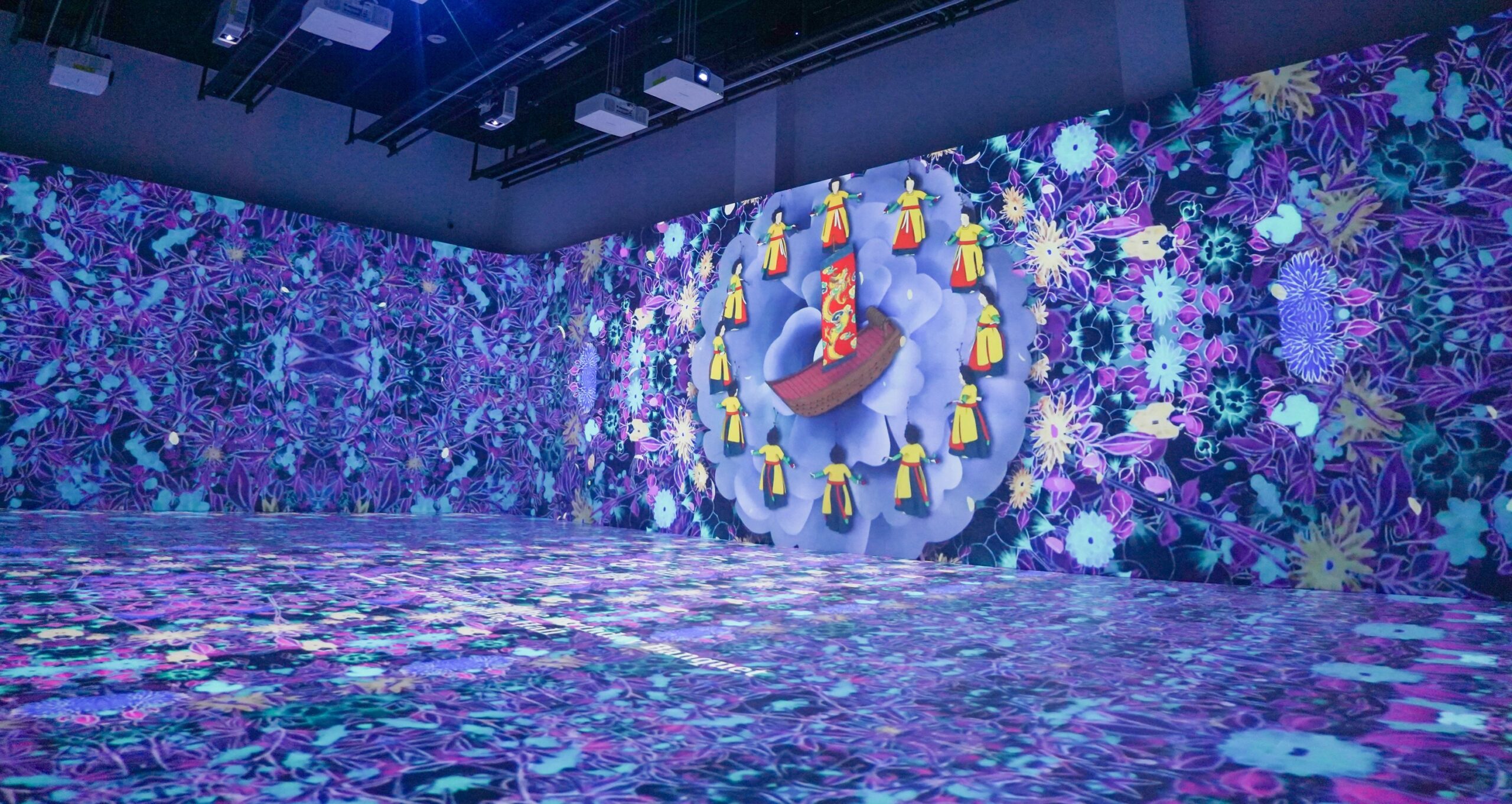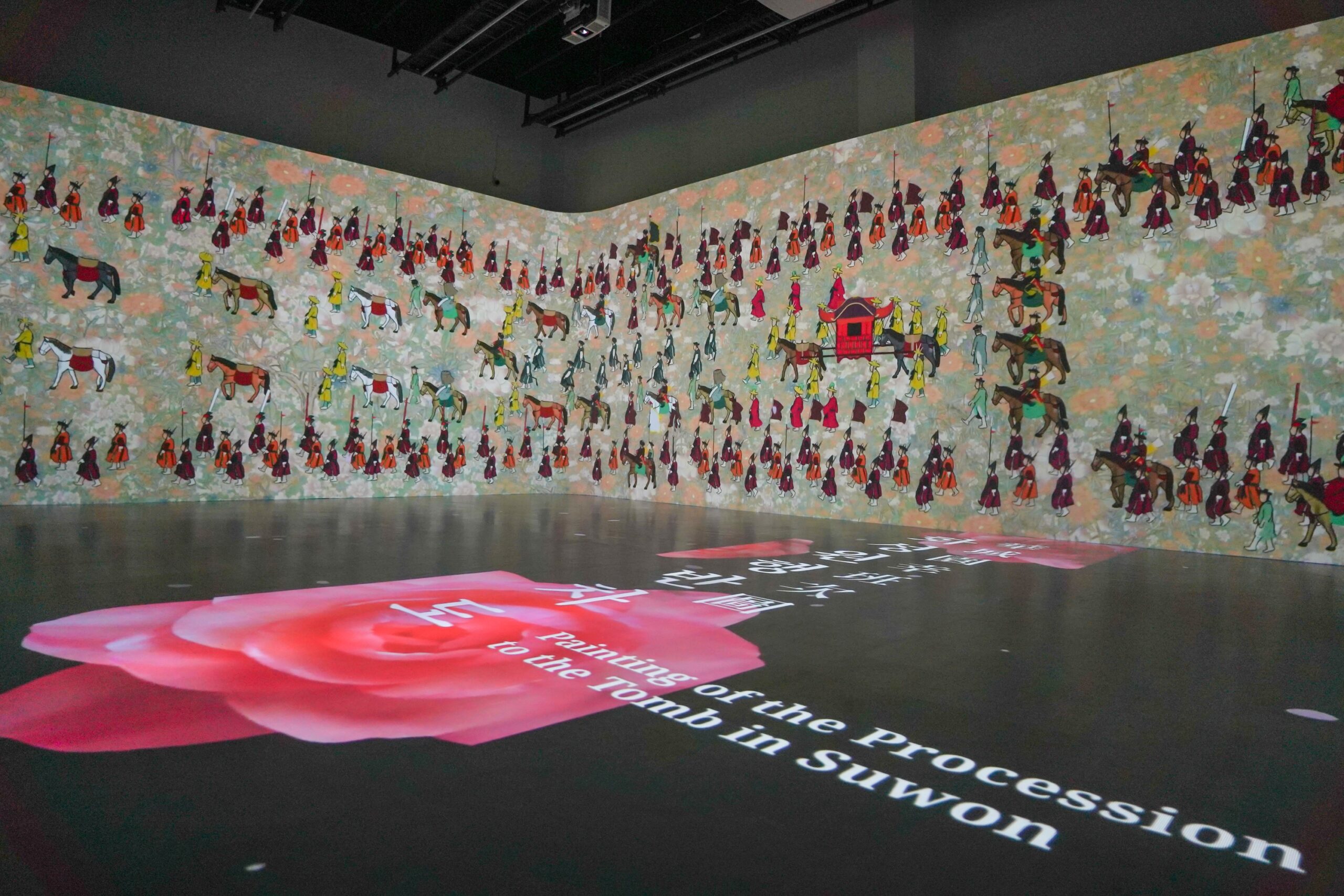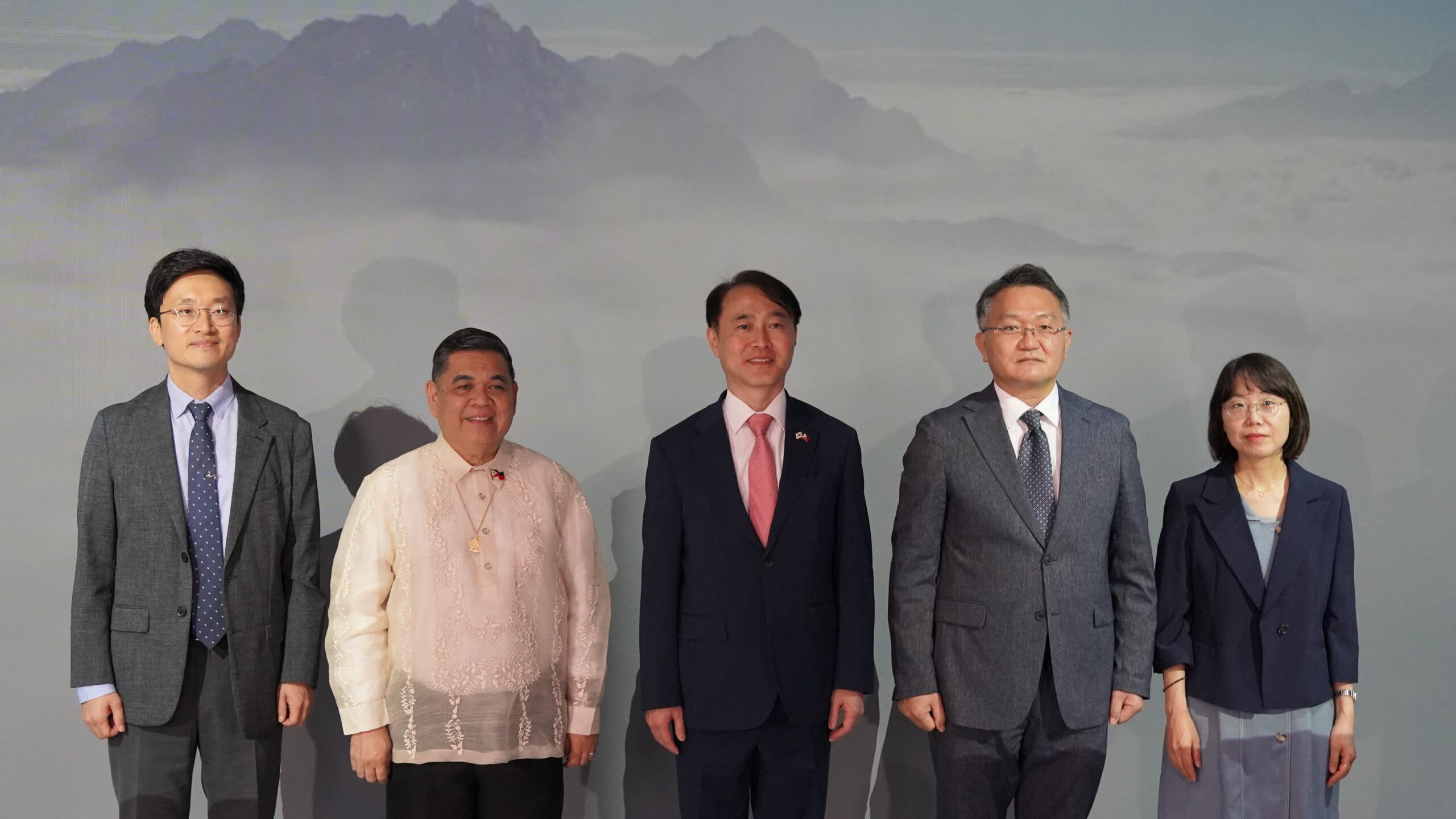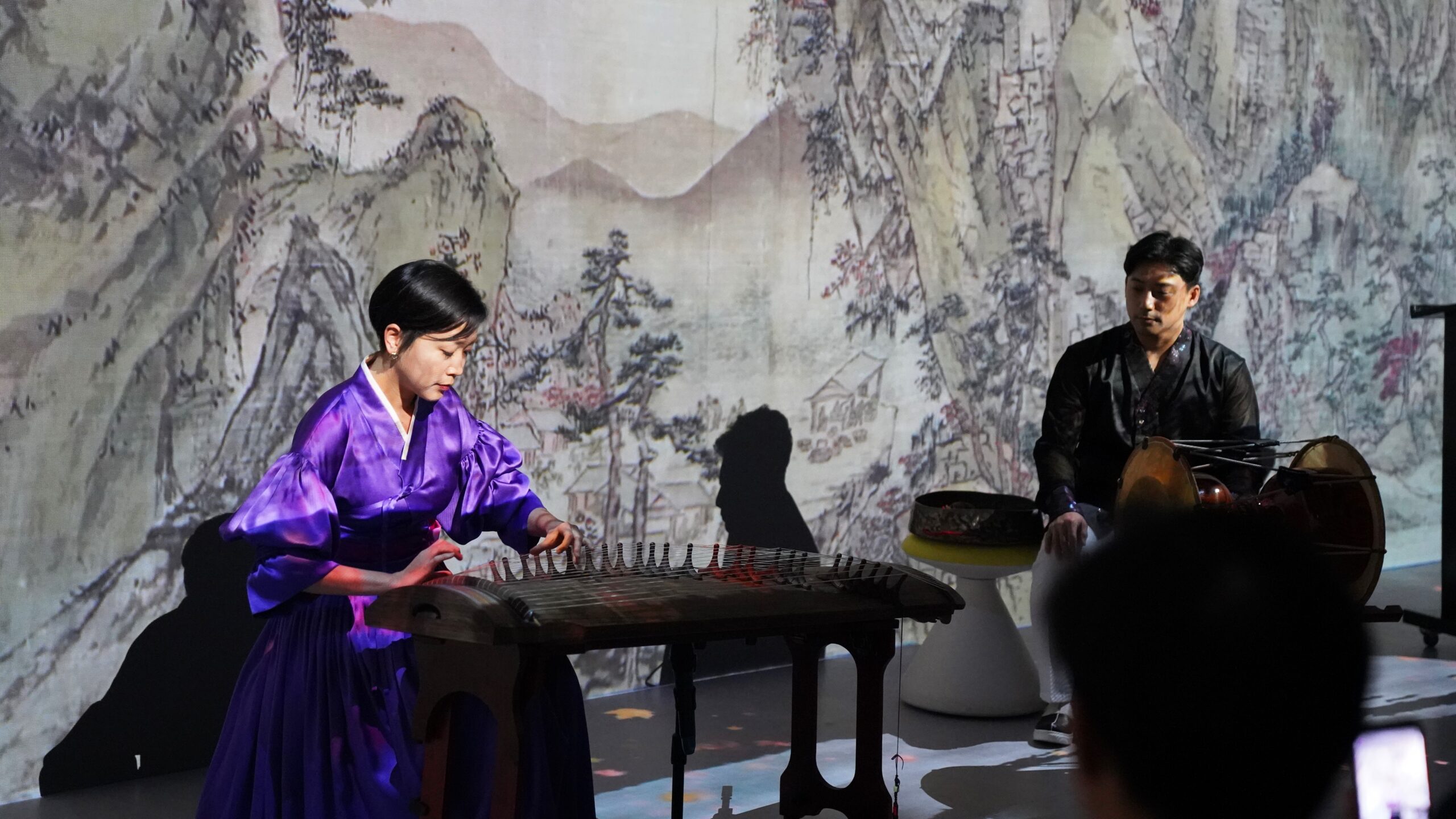| · Exhibition Title: Endless Landscape: Digitally Reimagined Korean Art
· Period: Friday, January 19 – Saturday, June 29, 2024 · Venue: 5th Floor, Multipurpose Hall, Korean Cultural Center in the Philippines · Featured Works: Immersive digital videos “Endless Mountains and Rivers,” “Royal Processions with the People,” “Pillars of Divinity, Chongseok Rocks,” and “Peonies in Bloom” |
The National Museum of Korea (Director General: Yoon Sung Yong) is presenting Endless Landscape: Digitally Reimagined Korean Art at the Korean Cultural Center in the Philippines (Director: Kim Myeongjin). This exhibition, featuring immersive video works using new digital technologies, will be held from Friday, January 19 through Saturday, June 29, 2024.
The First Achievement of the NMK’s Overseas Korean Galleries Support Program in the Philippines
This exhibition is the first outcome in the Philippines of the National Museum of Korea’s Overseas Korean Galleries Support Program. In an effort to establish a foundation to broaden the reach of K-culture, the National Museum of Korea is promoting customized support programs to fit the local characteristics of different countries around the world. In the Philippines, the absence of Korean galleries or museums housing Korean cultural heritage makes it challenging for local audience to experience traditional Korean cultural content. In this light, the exhibition takes a new approach to surmount the constraints of hosting artifact-centered exhibitions of Korean art. By presenting immersive video works using the latest digital technology, the stories in cultural heritage can be conveyed in a vibrant and engaging way. Moreover, this digital approach can be particularly effective given the deep interest in Korean pop culture, including K-pop and TV shows, among many Filipinos. Through friendly and familiar digital medium, the exhibition is expected to enjoy a greater public response through this convergence of tradition and modernity.
This year marks the 75th anniversary of diplomatic relations between Korea and the Philippines. Endless Landscape: Digitally Reimagined Korean Art has been organized to commemorate the long-standing friendship between the two countries by expanding the reach of Korean cultural content in the Philippines and promoting mutual exchange. This exhibition kicks off a series of events celebrating this diplomatic anniversary at the Korean Cultural Center in the Philippines, including a Korea Festival and K-drama OST Concert.
The accompanying performances to the exhibition will diversify the exhibition’s local impact and visitor experience. In collaboration with the National Commission for Culture and the Arts of the Philippines (NCCA), the Korean Cultural Center in the Philippines will organize monthly house concerts featuring Filipino artists. NCCA, the country’s official government agency for supporting culture, has provided active support to ensure the exhibition takes place successfully. In this way, the leading cultural institutions of Korea and the Philippines have come together to further strengthen cultural exchanges and cooperation between the two countries.

A Unique Exhibition of K-Culture Marked by an Intersection of the Past and Present
The exhibition presents four video works using new digital technologies produced by the National Museum of Korea and the Chuncheon National Museum. The works – respectively entitled “Endless Mountains and Rivers,” “Royal Processions with the People,” “Pillars of Divinity, Chongseok Rocks,” and “Peonies in Bloom” – are reinterpretations of traditional Korean paintings. This exhibition is significant in that it offers a novel approach through digital content to engage with traditional Korean paintings, which are typically inaccessible without a visit to Korea.
Upon entering the gallery, visitors are welcomed by an expansive panorama. Overflowing with light, sound, and brilliant colors, the exhibition space presents an intense sense of immersion. Visitors are enveloped in a rich tapestry of the unique landscapes, ambience, and history embodied within Korean traditional paintings. This unconventional approach featuring the intersection of cultural heritage from the past and the digital technology of the present is expected to provide viewers with a new experience that goes beyond the emotional impact of the original works.

The first video work, “Endless Mountains and Rivers: A Prosperous World Unfolds in Nature,” is based on Endless Mountains and Rivers, a masterpiece by Yi Inmun (1745–after 1824), a royal court painter during the Joseon Dynasty (1392–1897). It provides a vivid rendition of people living in harmony with immutable nature. This vibrant coexistence of humans and nature represents a prosperous world–a utopia that people in the late Joseon Dynasty sought to realize. The second video, entitled “Royal Processions with the People,” is based on the official uigwe (royal protocols) records of the ceremonies of the Joseon royal court. Based on these royal records and paintings, it invites visitors into a world of majestic royal rites centered on the processions to Hwaseong Fortress in Suwon by King Jeongjo (r. 1776–1880), the 22nd King of the Joseon Dynasty. King Jeongjo may be known to international audiences through the Korean historical drama The Red Sleeve. The third video work, “Pillars of Divinity, Chongseok Rocks,” illustrates the spectacular view of Chongseok Rocks in Tongcheon, Gangwondo Province, which is a renowned scenic attraction in the Geumgangsan Mountain area. This video is based on the painting Scenic View of Chongseok Rocks by the painter and calligrapher Kim Gyujin (1868–1933). The painting was commissioned by Emperor Sunjong, the second ruler of the Korean Empire (1897–1910). It once decorated Heejeongdang Hall, his office at Changdeokgung Palace. The spectacular view of Chongseok Rocks is characterized by a series of hexagonal rock pillars that appear as if they were sculpted by divine hands. It has been transformed into an immersive video that brings the scene to life for visitors. “Peonies in Bloom,” the fourth work, is based on a two-panel painting of peony flowers in the National Museum of Korea collection. It was originally installed in a palace building during the Joseon Dynasty. Celebrated as “the king of flowers” for their splendid and elegant appearance, peonies have long served as an object of admiration, a symbol of wealth and abundance, and an important motif for royal rites and architecture. The video work transports visitors into a sumptuous garden of red and white peony blossoms in full bloom.

Mr. Yoon Sung Yong, the Director General of the National Museum of Korea, commented,
“The National Museum of Korea is promoting a variety of programs to support overseas Korean galleries and exhibitions to enhance global understanding of Korean culture. I hope that this exhibition focusing on digital content, which goes beyond conventional artifact-centered exhibitions, will serve as a unique opportunity to introduce Korean culture to the Filipino public.”
H.E. Lee Sang-hwa, the Ambassador of the Republic of Korea to the Philippines, mentioned, “As the first event to celebrate 75 years of friendship between Korea and the Philippines, this exhibition provides a great opportunity for meaningful cultural exchanges between our two countries. I hope that it will showcase Korea’s rich tradition and substantiate its position as a digital powerhouse that can further strengthen our bilateral partnership.”
The National Museum of Korea will continue to carry out further projects and overseas exhibitions as part of its Overseas Korean Galleries Support Program to ensure the preservation and utilization of Korean galleries and cultural heritage located abroad. It is hoped that this exhibition will provide an opportunity for closer engagement with Korean art and culture. The museum will strive to promote Korean culture and strengthen its status through diverse projects that encompass both traditional and contemporary contexts.
Attachments
- Information on the Immersive Digital Videos
- Exhibition Poster and Installation Views
- Opening Ceremony Photos
Attachment 1. Information on the Immersive Digital Videos
(1) “Endless Mountains and Rivers: A Prosperous World Unfolds in Nature”
Multi-channel Video Production, Panorama Media (12:24 mins)
Endless Mountains and Rivers is a masterpiece from the history of Korean painting created by Yi Inmun (1745–after 1824), a royal court painter during the Joseon Dynasty (1392–1897). Yi poured his immense skill and effort into this work. Spanning a scroll more than 8.5 meters long, it depicts the lives of people living in harmony with immutable nature. The work features scenes of mountains ablaze with autumn reds and rocky cliffs unfolding seemingly without end. People navigate by boats and transport goods using carts, donkeys and pulleys, connecting mountains, rivers and villages. This vibrant coexistence of humans and nature represents a prosperous world – a utopia that people in the late Joseon Dynasty sought to realize.
(2) “Royal Processions with the People”
Multi-channel Video Production, Panorama Media (11:21 mins)
Registered officially as a UNESCO Memory of the World, Uigwe offers a unique record of Korea’s heritage, documenting over 500 years of important royal ceremonies during the Joseon Dynasty through text and illustrations. The immersive digital work “Royal Processions with the People” is based on Uigwe and other royal records and paintings from the collection of the National Museum of Korea. This video centers on two major events: the 1795 procession of King Jeongjo (r. 1752–1800), the 22nd King of the Joseon Dynasty, to Hwaseong Fortress, and a banquet held in 1796 to celebrate the completion of that magnificent structure. This work vividly recreates the grand procession, the banquet with dancing and music, and the precise military drills of the era, offering viewers an opportunity to immerse themselves in the festivities that happened more than two centuries ago.
(3) “Pillars of Divinity, Chongseok Rocks”
Multi-channel Video Production, Panorama Media (4:30 mins)
Chongseok Rocks, located in Tongcheon, Gangwondo Province, is a renowned scenic attraction within the Geumgangsan Mountain area, forming a stunning vista with its series of hexagonal rock pillars lining the coast. Appearing as if carved by divine hands, this landscape has inspired numerous legends and captivated many writers and painters. Emperor Sunjong of the Korean Empire (1897–1910) commissioned the painter and calligrapher Kim Gyujin (1868–1933) to create Scenic View of Chongseok Rocks, an 8.8-meter-long painting, to decorate Heejeongdang Hall, his office in Changdeokgung Palace. The painting’s portrayal of the sublime and unusual landscape of Chongseok Rocks has been vividly transformed into a video, bringing the scene to life for viewers.
(4) “Peonies in Bloom”
Multi-channel Video Production, Panorama Media (2:34 mins)
Peonies, which bloom with lush red and white blossoms in late spring, are celebrated as the “king of flowers” for their opulent beauty. In Korea, peonies have long been cherished not only for their aesthetic appeal but also as symbols of wealth and prosperity. They are also esteemed emblems, frequently used to adorn royal ceremonies and buildings. The digital immersive video “Peonies in Bloom” is based on a two-panel peony painting from the National Museum of Korea which was originally installed in a Joseon Dynasty palace. This video transports viewers into a sumptuous garden of peonies, evoking the splendor and majesty associated with the royal family as the flowers burst into vibrant bloom.
Attachment 2. Exhibition Poster and Installation Views
| Fig 1. Exhibition Poster | Fig 2. Korean Cultural Center in the Philippines |
| Fig 3. Installation View (Endless Mountains and Rivers) | Fig 4. Installation View (Endless Mountains and Rivers) |
| Fig 5. Installation View
(Royal Processions with the People) |
Fig 6. Installation View
(Royal Processions with the People) |
| Fig 7. Installation View (Chongseok Rocks) | Fig 8. Installation View (Peonies in Bloom) |

Attachment 3. Opening Ceremony Photos
| Fig 1. Gayageum Artist Ju Bora performs at the Opening Ceremony | Fig 2. Bayanihan Dance Company performs at the Opening Ceremony |
| Fig 3. (L-R) Kim Myeongjin, Korean Cultural Center Director, Oscar Casaysay, National Commission for Culture and the Arts Executive Director, Lee Sang-hwa, Ambassador of Korea to the Philippines, Kim Dohyung, National Museum of Korea Executive Director of the Education & Cultural Bureau and Jeong Myounghee , National Museum of Korea Exhibition Division Head | Fig 4. Ambassador Lee Sang-hwa |

Source: Beautiful Feature
0 Comments